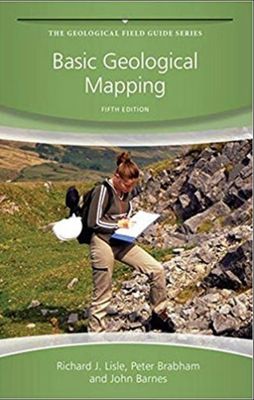
Lýsing:
Part of The Geological Field Guide Series , Basic Geological Mapping , 5 th Edition is an essential basic guide to field techniques in mapping geology. Now completely revised and updated the book retains the concise clarity which has made it an indispensable instant reference in its previous editions. It provides the reader with all the necessary practical information and techniques that they will need while carrying out work in the field, covering a wide spectrum of different conditions, needs and types of countries.
Annað
- Höfundar: Richard J. Lisle, Peter Brabham, John W. Barnes
- Útgáfa:5
- Útgáfudagur: 2011-09-07
- Hægt að prenta út 10 bls.
- Hægt að afrita 2 bls.
- Format:ePub
- ISBN 13: 9781119977513
- Print ISBN: 9780470686348
- ISBN 10: 1119977517
Efnisyfirlit
- Cover
- The Geological Field Guide Series
- Title
- Copyright
- Preface to The Fourth Edition
- Preface to The Fifth Edition
- Chapter 1: Introduction
- 1.1 Outline and Approach
- 1.2 Safety
- 1.3 Field Behaviour
- 1.4 A Few Words of Comfort
- Chapter 2: Field Equipment
- 2.1 Hammers and Chisels
- 2.2 Compasses and Clinometers
- 2.3 Hand Lenses
- 2.4 Tapes
- 2.5 Map Cases
- 2.6 Field Notebooks
- 2.7 Scales
- 2.8 Protractors
- 2.9 Pencils, Erasers and Mapping Pens
- 2.10 Acid Bottles
- 2.11 Global Positioning System (GPS) and Mobile Phones
- 2.12 Other Instruments
- 2.13 Field Clothing
- Chapter 3: Topographic Base Maps
- 3.1 Types of Geological Map
- 3.2 Topographic Base Maps
- 3.3 Geographic Coordinates and Metric Grids
- 3.4 Grid Magnetic Angle
- 3.5 Position Finding on Maps
- 3.6 Use of Air Photography as a Mapping Tool
- 3.7 Suitability of Images for Geological Mapping
- Chapter 4: Methods of Geological Mapping
- 4.1 Strategy for the Mapping Programme
- 4.2 Mapping by Following Contacts
- 4.3 Traversing
- 4.4 Exposure Mapping
- 4.5 Mapping in Poorly Exposed Regions
- 4.6 Superficial Deposits
- 4.7 Drilling
- 4.8 Geophysical Aids to Mapping
- 4.9 Large-Scale Maps of Limited Areas
- 4.10 Underground Mapping
- 4.11 Photogeology
- Chapter 5: Technological Aids to Mapping
- 5.1 Digital Terrain Models
- 5.2 Topographic Surveying Techniques
- Chapter 6: Field Measurements and Techniques
- 6.1 Measuring Strike and Dip of Planar Structures
- 6.2 Plotting Strike and Dip
- 6.3 Recording Strike and Dip
- 6.4 Measuring Linear Features
- 6.5 Folds
- 6.6 Faults
- 6.7 Thrusts
- 6.8 Joints
- 6.9 Unconformities
- 6.10 Map Symbols
- 6.11 Specimen Collecting
- 6.12 Field Photography
- 6.13 Panning
- Chapter 7: Mappable Rock Units and Lithology
- 7.1 Lithostratigraphy and Sedimentary Rocks
- 7.2 Sedimentary Formations
- 7.3 Rock Descriptions
- 7.4 Identifying and Naming Rocks in the Field
- 7.5 Fossils
- 7.6 Phaneritic Igneous Rocks
- 7.7 Aphanitic Igneous Rocks
- 7.8 Veins and Pegmatites
- 7.9 Igneous Rocks in General
- 7.10 Pyroclastic Rocks
- 7.11 Metamorphic Rocks
- 7.12 Economic Geology
- Chapter 8: Field Maps and Field Notebooks
- 8.1 Field Maps
- 8.2 Field Notebooks
- Chapter 9: Fair Copy Maps and Other Illustrations
- 9.1 Fair Copy Maps
- 9.2 Transferring Topography
- 9.3 Transferring Geology
- 9.4 Lettering and Symbols
- 9.5 Formation Letters
- 9.6 Layout
- 9.7 Colouring
- 9.8 Stratigraphic Column
- 9.9 Overlays
- 9.10 Computer Drafting of the Fair Copy Map
- Chapter 10: Cross-Sections and 3D Illustrations
- 10.1 Cross-Sections
- 10.2 Method of Apparent Dips
- 10.3 Down-Plunge Projection Method
- 10.4 Balanced Cross-Sections
- 10.5 Columnar Sections
- 10.6 Block Diagrams
- 10.7 Models
- Chapter 11: Geological Reports
- 11.1 Preparation
- 11.2 Revising and Editing
- 11.3 Layout
- 11.4 The ‘Introduction’
- 11.5 Main Body of the Report
- 11.6 The ‘Conclusions’ Section
- 11.7 Text Illustrations
- 11.8 References
- 11.9 Appendices
- 11.10 Some Final Thoughts
- Appendix A: Adjustment of a Closed Compass Traverse
- Appendix B: Field Equipment Checklist
- Appendix C: Indicators of Stratigraphical Way-Up
- Appendix D: Useful Chart and Tables
- References
- Index
- Selected Map Symbols
- Colour Plates
- End User License Agreement
UM RAFBÆKUR Á HEIMKAUP.IS
Bókahillan þín er þitt svæði og þar eru bækurnar þínar geymdar. Þú kemst í bókahilluna þína hvar og hvenær sem er í tölvu eða snjalltæki. Einfalt og þægilegt!Rafbók til eignar
Rafbók til eignar þarf að hlaða niður á þau tæki sem þú vilt nota innan eins árs frá því bókin er keypt.
Þú kemst í bækurnar hvar sem er
Þú getur nálgast allar raf(skóla)bækurnar þínar á einu augabragði, hvar og hvenær sem er í bókahillunni þinni. Engin taska, enginn kyndill og ekkert vesen (hvað þá yfirvigt).
Auðvelt að fletta og leita
Þú getur flakkað milli síðna og kafla eins og þér hentar best og farið beint í ákveðna kafla úr efnisyfirlitinu. Í leitinni finnur þú orð, kafla eða síður í einum smelli.
Glósur og yfirstrikanir
Þú getur auðkennt textabrot með mismunandi litum og skrifað glósur að vild í rafbókina. Þú getur jafnvel séð glósur og yfirstrikanir hjá bekkjarsystkinum og kennara ef þeir leyfa það. Allt á einum stað.
Hvað viltu sjá? / Þú ræður hvernig síðan lítur út
Þú lagar síðuna að þínum þörfum. Stækkaðu eða minnkaðu myndir og texta með multi-level zoom til að sjá síðuna eins og þér hentar best í þínu námi.
Fleiri góðir kostir
- Þú getur prentað síður úr bókinni (innan þeirra marka sem útgefandinn setur)
- Möguleiki á tengingu við annað stafrænt og gagnvirkt efni, svo sem myndbönd eða spurningar úr efninu
- Auðvelt að afrita og líma efni/texta fyrir t.d. heimaverkefni eða ritgerðir
- Styður tækni sem hjálpar nemendum með sjón- eða heyrnarskerðingu
- Gerð : 208
- Höfundur : 8448
- Útgáfuár : 2011
- Leyfi : 379


